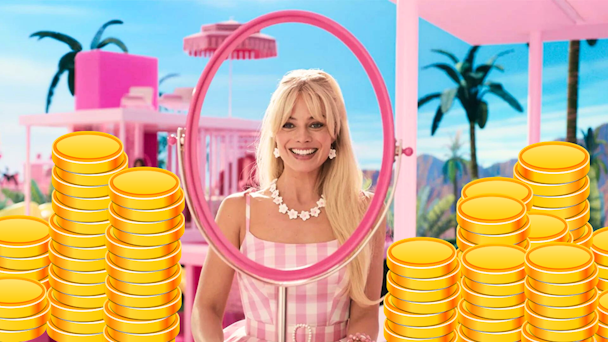Barbie’s success shows that the branded blockbuster is the future of marketing
David Incorvaia, founder and creative director of Lure, believes brands have to think Barbie-big to cut through in 2023. He passionately believes that marketers should be creating culture rather than reacting to it.

Regardless of where one landed in the midst of this summer’s cinematic clash of Barbenheimer, the real triumph belonged to Mattel, the owner of Barbie, whose film amassed a cool $400m in its debut week.
Meanwhile, when I engage in conversations with chief marketing offers from some of Europe’s largest brands, they frequently brush off the notion that their brand could captivate audiences beyond a 30-second advert, much less a full-length film or series. Why are marketing teams sabotaging their success by ignoring the blockbuster potential of branded storytelling, or is there a deeper misunderstanding about what audiences genuinely want and engage with?
Let’s transport ourselves back to the early 1950s.
The 1950s
It was a time when the broadcasting landscape was beginning to take shape. Early radio and television programs were wholly directed by their sponsors, with offerings like The Colgate Comedy Hour, Hallmark Hall of Fame and Westinghouse Studio One. These sponsors commandeered the entirety of the program production, with broadcasters providing only the studios and airtime. Beloved TV series like I Love Lucy or The Honeymooners, which reached millions each week, began as branded sketches by corporations such as Lucky Strike. Procter and Gamble, for example, produced the daily soap As the World Turns, marking a phenomenal 54-year run and giving birth to the soap-opera genre.
Advertisement
Leapfrogging to modern times, Hallmark successfully ran a TV channel from 1988-1992. Automaker BMW launched The Hire in 2001, a series of short films helmed by esteemed directors like Guy Ritchie and Ang Lee, amassing over 100m views.
Energy drink giant Red Bull had wielded branded content extensively in its marketing tactics, transforming into a bona fide entertainment studio that launched individuals into space – before that became the tiresome pastime of billionaires.
Since 2003, Lego has been churning films and series based on its toys. Its 2014 film, The Lego Movie, raked in $468.1m and secured an 81% rating on Rotten Tomatoes.
Few foresaw the box office boom that Barbie would experience, nearly matching this in its opening weekend alone. Barbie the film unabashedly flaunted Mattel’s involvement, prominently featuring Mattel’s board of trustees, led by Will Ferrell, as the essential antagonist.
Advertisement
HBO’s The Last of Us, a tremendous hit series adapted from a video game, and Apple’s Ted Lasso, designed to drive awareness for its English football league, were massive triumphs for branded entertainment. Today, streaming platforms from Disney, Nation Geographic, Hulu, Amazon Prime to Apple Plus are co-producing and releasing films and series produced with brands on their channels, reaching millions.
And yet...
There persists a stigma around branded entertainment among our marketing brethren.
The crux of the issue doesn’t lie with audiences. Instead, it seems rooted in the mindset of marketers. Many of these professionals, often in their 30s and 40s, have been trained in concepts such as ‘digital first,‘ ‘viral‘ and ‘influencer marketing.‘
These ideas have shaped a belief that audiences will only engage with a video for up to 30 seconds. Despite evidence to the contrary, these guidelines persist in many agency and brand discussions. It’s a curious phenomenon that reveals something about human nature: We sometimes find it difficult to let go of familiar practices, even when evidence suggests embracing change could offer substantial rewards for the brands we love and serve.
I hear a common counterargument: “Sure, Red Bull or Nike can craft a story people will watch, but not my brand.”
Suggested newsletters for you
Please allow me to address all the CMOs reading this momentarily: You ALL think other brands are cooler. During my 22-year career, Coca-Cola, Johnson & Johnson, and even Audi say: “People would watch something from (insert cool competitor name), but not from us.”
My point. It’s time to overcome your brand envy.
While I consider Airbnb a trendy brand, it isn’t typically associated with brands like Nike or Red Bull. Nonetheless, it independently produced a documentary, ‘Gay Chorus Deep South,’ in 2019. The film, which chronicled a 2017 tour of the Southeastern United States by the San Francisco Gay Men’s Chorus, premiered at the Tribeca Film Festival and garnered several awards.
Did you know that Dove, the humble soap manufacturer, produced an Oscar-winning animated short film?
Don’t worry; your audiences did.
Let me take a moment to clarify: I’m not devaluing TV commercials or print ads. Every day, I craft campaigns for clients that span TV and print. These channels remain vitally relevant in today’s marketing ecosystem when they’re the optimal choice for reaching particular audiences, especially when a story resonates within a 30-second spot or on a printed page.
The emphasis should be on the ‘ecosystem‘ rather than the channel. I’m urging brands and media companies to unreservedly integrate long-form storytelling into their strategies, treating it with the same importance as stories conveyed through TV, print or social media.
I can vouch from personal experience that advocating for long-form series is no cakewalk. When I suggested a video series for Coca-Cola featuring chefs crafting original dishes, there was resistance. Many pointed to the 30-second Coke TV influencer selfie videos as the benchmark for original content, arguing anything longer would fall flat. It also posited that if the films did gain traction and weren’t overtly branded, no one would connect them with Coke.
Thankfully, visionaries like Michael Willeke, Lars Senhen, and Natassja dos Anjos recognized the potential, and the German series reached 25 million individuals in a nation of 85 million. It became the first branded series to air organically on Amazon Prime in Germany. Furthermore, it bolstered the brand with a 6% market share increase and earned us an Effie. [See it here].
Many at the energy company E.On (also a client) initially balked at the idea of a series, with several voices in the marketing department adamantly asserting, “I’ve been in this business for 20 years, and honestly, no one cares about energy.” Luckily, smart folks like Stefanie Eller, Axel Löber and Patrick Lammers held a broader vision. Our 12-part series, each episode lasting 10 minutes and focusing on E.On’s sustainable energy projects, accumulated over 100m views on YouTube, marking the company’s most successful communication campaign.
So that means...
The problem isn’t audiences; it’s marketers.
Brands fall into two categories: Those clinging to outdated methodologies and those acknowledging the potential windfall in weaving their brand’s narrative into entertainment. Today, a growing number of the world’s most prominent brands are appointing individuals to positions such as ‘head of content‘ or ‘vice-president of global storytelling.‘ This suggests that these organizations have evolved beyond a ‘let‘s give it a shot‘ mentality, recognizing the importance of such tactics for their brand’s future, making them an intrinsic part of their communication and PR fabric.
What sparked this shift?
The internet.
It fundamentally revolutionized how we consume entertainment. Often, marketers credit this to the on-demand nature of internet content, allowing audiences to choose when and what to watch. But even in my 80s childhood in Cleveland, my parents recorded shows like SNL on our VCR when I protested against bedtime. That was already in demand. The real game-changer was the elimination of mandatory TV ad breaks every five to ten minutes, replaced by ad-free, subscription-based services. We owe this sea change to you, Tony Soprano.
But even amid change, human behavior is sluggish to adapt.
A 2019 New York Times headline, “The Advertising Industry has a Problem: People Hate Ads,” rattled cages. It spotlighted how particularly affluent young consumers were paying to bypass ads. In the article, Marc Pritchard, Procter & Gamble’s chief brand officer, noted, “We tried to change the advertising ecosystem by doing more ads, and all that did was create more noise. Ads are often irrelevant and sometimes just silly, ridiculous, or stupid.”
Numerous bodies of research indicate that people prefer to be entertained than interrupted. But how to be entertaining?
To quote Robin Williams in Aladdin, “Be yourself.”
Your story is the bridge that naturally forms between your brand DNA and the audience you want to entertain. With that purpose as a guiding light, today’s brands must aspire to be entertaining storytellers. The weight lies in the narrative, not in how many seconds the brand logo is visible.
Branded entertainment must step out of the commercials’ shadows and take its rightful place alongside Hollywood blockbusters. By latching on to this truth, CMOs can leap into a world of opportunity - a realm where their brands don’t just fill 30-second commercial breaks but captivate audiences for hours, creating loyalists and advocates out of casual viewers. After all, if a doll can amass 400 million in a week, imagine what your brand could do.
David Beebe, the former vice-president of Marriott’s global creative and content marketing, has often been quoted saying, “Stop interrupting what people are interested in, and become what they’re interested in.”
David Incorvaia studied filmmaking at Rhode Island School of Design and Saint Martin’s College. He’s an award-winning creative director and led campaigns for BMW, Audi, Coca-Cola, Johnson and Johnson, Becks and Asics. He is American and lives in Berlin.

